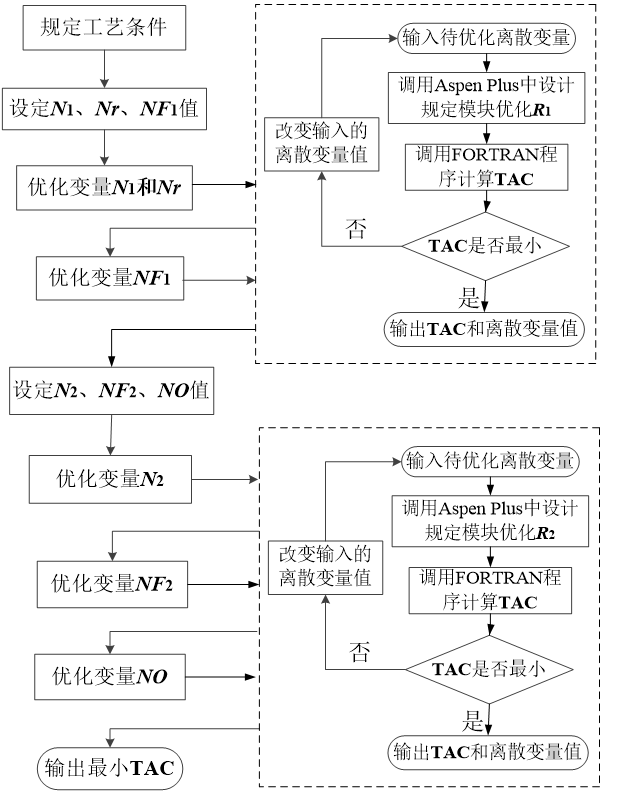醋酸甲酯水解工艺厂级经济优化与动态控制系统设计毕业论文
2020-04-15 21:01:45
摘 要
在化工流程中反应精馏塔发挥着重要作用,其将反应和分离耦合在一起,相当有效的促进了反应选择性并提高原料转化率。本文针对PTA生产系统中的副产物醋酸甲酯催化水解工艺,研究了基于Aspen Plus仿真的厂级动态控制系统。醋酸甲酯水解工艺主要包含进料混合罐、反应器、反应精馏塔和甲醇回收塔等四个单元,其中反应精馏塔和甲醇回收塔之间存在强耦合性,所以对醋酸甲酯水解装置的厂级动态控制带来了挑战。在经济优化的基础上通过Aspen Plus建立醋酸甲酯水解装置的稳态模型,对醋酸甲酯水解工艺进行厂级控制方案设计并对动态模型进行模拟分析。首先确定系统的控制目标,分析整个醋酸甲酯工艺系统的开环动态特性;根据控制自由度选择被控变量,根据先部分后整体的思路设计厂级控制方案;在稳态模型的基础上添加阀门和泵再转化为动态模型,在动态模型中加入设计的控制方案,并添加相应合适的扰动,最后利用Aspen Dynamics进行仿真。
关键词:醋酸甲酯水解;Aspen Plus;稳态模拟;厂级控制方案;动态模拟
Plant-level economic optimization and dynamic control system design for methyl acetate hydrolysis process
ABSTRACT
The reactive rectification column plays an important role in the chemical process, which couples the reaction and separation together, which is quite effective in promoting reaction selectivity and increasing feedstock conversion. In this paper, a plant-level dynamic control system based on Aspen Plus simulation was studied for the catalytic hydrolysis of methyl acetate as a by-product in the PTA production system. The methyl acetate hydrolysis process mainly comprises four units of a feed mixing tank, a reactor, a reactive rectification column and a methanol recovery tower, wherein there is strong coupling between the reaction rectification column and the methanol recovery column, so the hydrolysis of methyl acetate is carried out. Plant-level dynamic control of the plant presents challenges. On the basis of economic optimization, the steady state model of methyl acetate hydrolysis unit was established by Aspen Plus. The plant-level control scheme was designed for methyl acetate hydrolysis process and the dynamic model was simulated. Firstly, the control target of the system is determined, and the open-loop dynamic characteristics of the whole methyl acetate process system are analyzed. The controlled variables are selected according to the degree of control freedom. The plant-level control scheme is designed according to the overall idea of the first part and the whole; the basis of the steady-state model is added. The valves and pumps are then converted into dynamic models, the design control scheme is added to the dynamic model, and the appropriate disturbances are added, and finally the simulation is performed using Aspen Dynamics.
KEYWORDS: Methyl acetate hydrolysis; Aspen Plus; Steady state simulation; Plant-level control scheme; Dynamic simulation
目 录
摘要 I
ABSTRACT II
第一章 绪论 1
1.1 课题研究背景与意义 1
1.2醋酸甲酯水解工艺研究现状 1
1.3厂级过程控制 2
1.4本文的主要工作与研究内容 2
第二章 醋酸甲酯催化水解工艺流程模拟 4
2.1 醋酸甲酯水解工艺流程 4
2.2 热力学分析 5
2.3 反应动力学模型 6
2.4 醋酸甲酯水解工艺稳态流程模拟 7
2.5塔内液相组成和气液相流分析 8
2.6 本章总结 10
第三章 醋酸甲酯水解稳态模型优化 11
3.1 基于年总成本(TAC)的最优化分析 11
3.2 TAC计算方法 11
3.3优化步骤 12
3.4 优化结果 13
3.5 本章小结 14
第四章 醋酸甲酯水解工艺过程控制与动态模拟 15
4.1 醋酸甲酯催化水解工艺控制目标 15
4.2 醋酸甲酯催化水解工艺动态特性分析 15
4.2.1 灵敏塔板分析 15
4.2.2系统开环动态特性分析 16
4.2.3 控制自由度分析 17
4.3 厂级控制系统设计 18
4.3.1 混合罐进料流量控制 18
4.3.2 反应器温度控制 19
4.3.3 反应精馏塔控制 19
4.3.4 甲醇回收塔控制 20
4.3.5 整体控制结构 21
4.4 本章小结 22
第五章 醋酸甲酯催化水解工艺控制系统动态模型 23
5.1 醋酸甲酯催化水解工艺流程动态模型 23
5.2 醋酸甲酯催化水解工艺动态模拟 24
5.3 控制器参数整定 25
5.4 控制系统动态响应 25
5.5 本章小结 28
第六章 总结与展望 30
6.1 工作小结 30
6.2 研究展望 30
参考文献 32
致 谢 33
第一章 绪论
1.1 课题研究背景与意义
在PTA(精对苯二甲酸)生产过程中,对二甲苯和醋酸利用液相高温氧化工艺,会发生很多副反应,其中最主要的副反应就是醋酸不完全燃烧产生醋酸甲酯[1]。醋酸氧化时有部分发生不完全氧化生成醋酸甲酯使得PTA生产效率低下,而且醋酸的损耗还提高了PTA工艺的生产成本[2]。
大多数生产厂家为了减少醋酸损耗和抑制醋酸甲酯的生成,他们会把部分回收的醋酸甲酯循环到PTA生产中。然而醋酸甲酯在生产系统中的不断循环导致醋酸甲酯的含量升高从而影响生产,并且最终会有部分随PTA的尾气进入大气中造成环境污染,而剩余的醋酸甲酯虽然回收但利用价值却不高[3]。
在绿色经济的化工兴业生产背景下,处理副产物醋酸甲酯的新工艺成为一大热点。醋酸甲酯催化水解可生成醋酸和甲醇,不仅处理了副产物醋酸甲酯,同时减少了环境污染又产生新的经济效益。醋酸甲酯催化水解工艺实现了醋酸甲酯的再利用,而且产物甲醇具有相当高的利用价值,是一种重要的化工生产原料[4]。
以上是毕业论文大纲或资料介绍,该课题完整毕业论文、开题报告、任务书、程序设计、图纸设计等资料请添加微信获取,微信号:bysjorg。
相关图片展示:







课题毕业论文、开题报告、任务书、外文翻译、程序设计、图纸设计等资料可联系客服协助查找。



